Identifying the Distribution and Frequency of Dust Storms in Iran Based on Long-Term Observations from over 400 Weather Stations
Abstract
1. Introduction
2. Details of Meteorological Datasets
2.1. Local Climate in Iran
2.2. Meteorological Stations and Datasets
2.3. Classification Codes of Dust Events
3. General Trends of the Dust Events in Entire Countries
3.1. Occurrence Frequency of Dust Events
3.2. Spatial Distribution of Dust in Three Categories
3.3. Spatial Distribution of Standard Deviation of Occurrence Frequencies in Three Categories
3.4. Breakdown of Occurrence Frequency and Distributions of Dust Events in Less Than 30 Days
4. Seasonal Variations
4.1. Seasonal Spatial Distribution of Suspended Dust
4.2. Seasonal Spatial Distribution of Rising Dust
4.3. Seasonal Spatial Distribution of Dust Storm
5. Long-Term Variation of the Dust Events
5.1. Monthly Dusty Days in 12 Years
5.2. Annual and Monthly Frequency of Dust Events for Three Classes
6. Conclusions
Author Contributions
Funding
Institutional Review Board Statement
Informed Consent Statement
Data Availability Statement
Acknowledgments
Conflicts of Interest
References
- Middleton, N.; Kang, U. Sand and Dust Storms: Impact Mitigation. Sustainability 2017, 9, 1053. [Google Scholar] [CrossRef]
- Mahmoudi, L.; Ikegaya, N. Present Situations of Dust Storms in Iran for Seeking Numerical Predictions. Proc. Int. Exch. Innov. Conf. Eng. Sci. 2022, 8, 354–359. [Google Scholar] [CrossRef]
- 2015.220669. The-Physics Pdf, 2nd ed.; Methuen & Co., Ltd.: London, UK, 1941. [Google Scholar]
- Zittis, G.; Almazroui, M.; Alpert, P.; Ciais, P.; Cramer, W.; Dahdal, Y.; Fnais, M.; Francis, D.; Hadjinicolaou, P.; Howari, F.; et al. Climate Change and Weather Extremes in the Eastern Mediterranean and Middle East. Rev. Geophys. 2022, 60, e2021RG000762. [Google Scholar] [CrossRef]
- Cuevas Agulló, E. Establishing a WMO Sand and Dust Storm Warning Advisory and Assessment System Regional Node for West Asia: Current Capabilities and Needs. Atmosphere 2013, 50, 91–96. [Google Scholar] [CrossRef]
- Sivakumar, M.V.; Motha, R.P.; Das, H.P. (Eds.) Natural Disasters and Extreme Events in Agriculture Impacts and Mitigation, 1st ed.; Springer: Berlin/Heidelberg, Germany, 2005. [Google Scholar]
- Ke, Y.; Wang, H.; Wu, Z.; Liu, S.; Zhao, T.; Yin, Y. Quantifying the Pollution Characteristics of Chemical Components in PM2.5 in the North China Plain, China: Spatiotemporal Variation and Health Risk. Atmos. Environ. 2023, 307, 119860. [Google Scholar] [CrossRef]
- Huang, X.; Ding, K.; Liu, J.; Wang, Z.; Tang, R.; Xue, L.; Wang, H.; Zhang, Q.; Tan, Z.M.; Fu, C.; et al. Smoke-Weather Interaction Affects Extreme Wildfires in Diverse Coastal Regions. Science 2023, 379, 457–461. [Google Scholar] [CrossRef]
- Miri, A.; Middleton, N. Long-Term Impacts of Dust Storms on Transport Systems in South-Eastern Iran. Nat. Hazards 2022, 114, 291–312. [Google Scholar] [CrossRef]
- Wang, H.; Ke, Y.; Tan, Y.; Zhu, B.; Zhao, T.; Yin, Y. Observational Evidence for the Dual Roles of BC in the Megacity of Eastern China: Enhanced O3 and Decreased PM2.5 Pollution. Chemosphere 2023, 327, 138548. [Google Scholar] [CrossRef]
- Tan, Y.; Wang, H.; Zhu, B.; Zhao, T.; Shi, S.; Liu, A.; Liu, D.; Pan, C.; Cao, L. The Interaction between Black Carbon and Planetary Boundary Layer in the Yangtze River Delta from 2015 to 2020: Why O3 Didn’t Decline so Significantly as PM2.5. Environ. Res. 2022, 214, 114095. [Google Scholar] [CrossRef]
- Chen, Q.; Wang, M.; Wang, Y.; Zhang, L.; Li, Y.; Han, Y. Oxidative Potential of Water-Soluble Matter Associated with Chromophoric Substances in PM2.5 over Xi’an, China. Environ. Sci. Technol. 2019, 53, 8574–8584. [Google Scholar] [CrossRef]
- Boroughani, M.; Hashemi, H.; Hosseini, S.H.; Pourhashemi, S.; Berndtsson, R. Desiccating Lake Urmia: A New Dust Source of Regional Importance. IEEE Geosci. Remote Sens. Lett. 2020, 17, 1483–1487. [Google Scholar] [CrossRef]
- Tanaka, T.Y.; Chiba, M. A Numerical Study of the Contributions of Dust Source Regions to the Global Dust Budget. Glob. Planet. Chang. 2006, 52, 88–104. [Google Scholar] [CrossRef]
- Sharifi, A.; Murphy, L.N.; Pourmand, A.; Clement, A.C.; Canuel, E.A.; Beni, A.N.; Lahijani, H.A.; Delanghe, D.; Ahmady-Birgani, H. Early-Holocene Greening of the Afro-Asian Dust Belt Changed Sources of Mineral Dust in West Asia. Earth Planet. Sci. Lett. 2018, 481, 30–40. [Google Scholar] [CrossRef]
- Francis, D.; Fonseca, R.; Nelli, N.; Bozkurt, D.; Cuesta, J.; Bosc, E. On the Middle East’s Severe Dust Storms in Spring 2022: Triggers and Impacts. Atmos. Environ. 2023, 296, 119539. [Google Scholar] [CrossRef]
- Ginoux, P.; Prospero, J.M.; Gill, T.E.; Hsu, N.C.; Zhao, M. Global-Scale Attribution of Anthropogenic and Natural Dust Sources and Their Emission Rates Based on MODIS Deep Blue Aerosol Products. Rev. Geophys. 2012, 50, 1–36. [Google Scholar] [CrossRef]
- Boloorani, A.D.; Nabavi, S.O.; Bahrami, H.A.; Mirzapour, F.; Kavosi, M.; Abasi, E.; Azizi, R. Investigation of Dust Storms Entering Western Iran Using Remotely Sensed Data and Synoptic Analysis. J. Environ. Health Sci. Eng. 2014, 12, 124. [Google Scholar] [CrossRef]
- Javadian, M.; Behrangi, A.; Sorooshian, A. Impact of Drought on Dust Storms: Case Study over Southwest Iran. Environ. Res. Lett. 2019, 14, 124029. [Google Scholar] [CrossRef]
- Rezazadeh, M.; Irannejad, P.; Shao, Y. Climatology of the Middle East Dust Events. Aeolian Res. 2013, 10, 103–109. [Google Scholar] [CrossRef]
- Hamzeh, N.H.; Kaskaoutis, D.G.; Rashki, A.; Mohammadpour, K. Long-Term Variability of Dust Events in Southwestern Iran and Its Relationship with the Drought. Atmosphere 2021, 12, 1350. [Google Scholar] [CrossRef]
- Modarres, R.; Sadeghi, S. Spatial and Temporal Trends of Dust Storms across Desert Regions of Iran. Nat. Hazards 2018, 90, 101–114. [Google Scholar] [CrossRef]
- Mesbahzadeh, T.; Miglietta, M.M.; Sardoo, F.S.; Krakauer, N.; Hasheminejad, M. Regional Analysis of Dust Day Duration in Central Iran. Appl. Sci. 2022, 12, 6248. [Google Scholar] [CrossRef]
- Mesbahzadeh, T.; Salajeghe, A.; Sardoo, F.S.; Zehtabian, G.; Ranjbar, A.; Krakauer, N.Y.; Miglietta, M.M.; Mirakbari, M. Climatology of Dust Days in the Central Plateau of Iran. Nat. Hazards 2020, 104, 1801–1817. [Google Scholar] [CrossRef]
- Baghbanan, P.; Ghavidel, Y.; Farajzadeh, M. Temporal Long-Term Variations in the Occurrence of Dust Storm Days in Iran. Meteorol. Atmos. Phys. 2020, 132, 885–898. [Google Scholar] [CrossRef]
- Beyranvand, A.; Azizi, G.; Alizadeh-Choobari, O.; Darvishi Boloorani, A. Spatial and Temporal Variations in the Incidence of Dust Events over Iran. Nat. Hazards 2019, 97, 229–241. [Google Scholar] [CrossRef]
- Alizadeh-Choobari, O.; Ghafarian, P.; Owlad, E. Temporal Variations in the Frequency and Concentration of Dust Events over Iran Based on Surface Observations. Int. J. Climatol. 2016, 36, 2050–2062. [Google Scholar] [CrossRef]
- Climate-Data-Historical. Available online: https://climateknowledgeportal.worldbank.org/about (accessed on 2 June 2023).
- Rashki, A.; Middleton, N.J.; Goudie, A.S. Dust Storms in Iran—Distribution, Causes, Frequencies and Impacts. Aeolian Res. 2021, 48, 100655. [Google Scholar] [CrossRef]
- Papi, R.; Kakroodi, A.A.; Soleimani, M.; Karami, L.; Amiri, F.; Alavipanah, S.K. Identifying Sand and Dust Storm Sources Using Spatial-Temporal Analysis of Remote Sensing Data in Central Iran. Ecol. Inform. 2022, 70, 101724. [Google Scholar] [CrossRef]
- Alizade Govarchin Ghale, Y.; Tayanc, M.; Unal, A. Dried Bottom of Urmia Lake as a New Source of Dust in the Northwestern Iran: Understanding the Impacts on Local and Regional Air Quality. Atmos. Environ. 2021, 262, 118635. [Google Scholar] [CrossRef]
- Rashki, A.; Kaskaoutis, D.G.; Goudie, A.S.; Kahn, R.A. Dryness of Ephemeral Lakes and Consequences for Dust Activity: The Case of the Hamoun Drainage Basin, Southeastern Iran. Sci. Total Environ. 2013, 463–464, 552–564. [Google Scholar] [CrossRef]
- Zucca, C.; Middleton, N.; Kang, U.; Liniger, H. Shrinking Water Bodies as Hotspots of Sand and Dust Storms: The Role of Land Degradation and Sustainable Soil and Water Management. Catena 2021, 207, 105669. [Google Scholar] [CrossRef]
- World Meteorological Organization. WMO Manual on Codes: International Codes, Volume I.1 Annex II to the WMO Technical Regulations: Part A—Alphanumeric Codes, 2017 ed.; World Meteorological Organization: Geneva, Switzerland, 2019; Volume I.1, ISBN 978-92-63-10306-2. [Google Scholar]
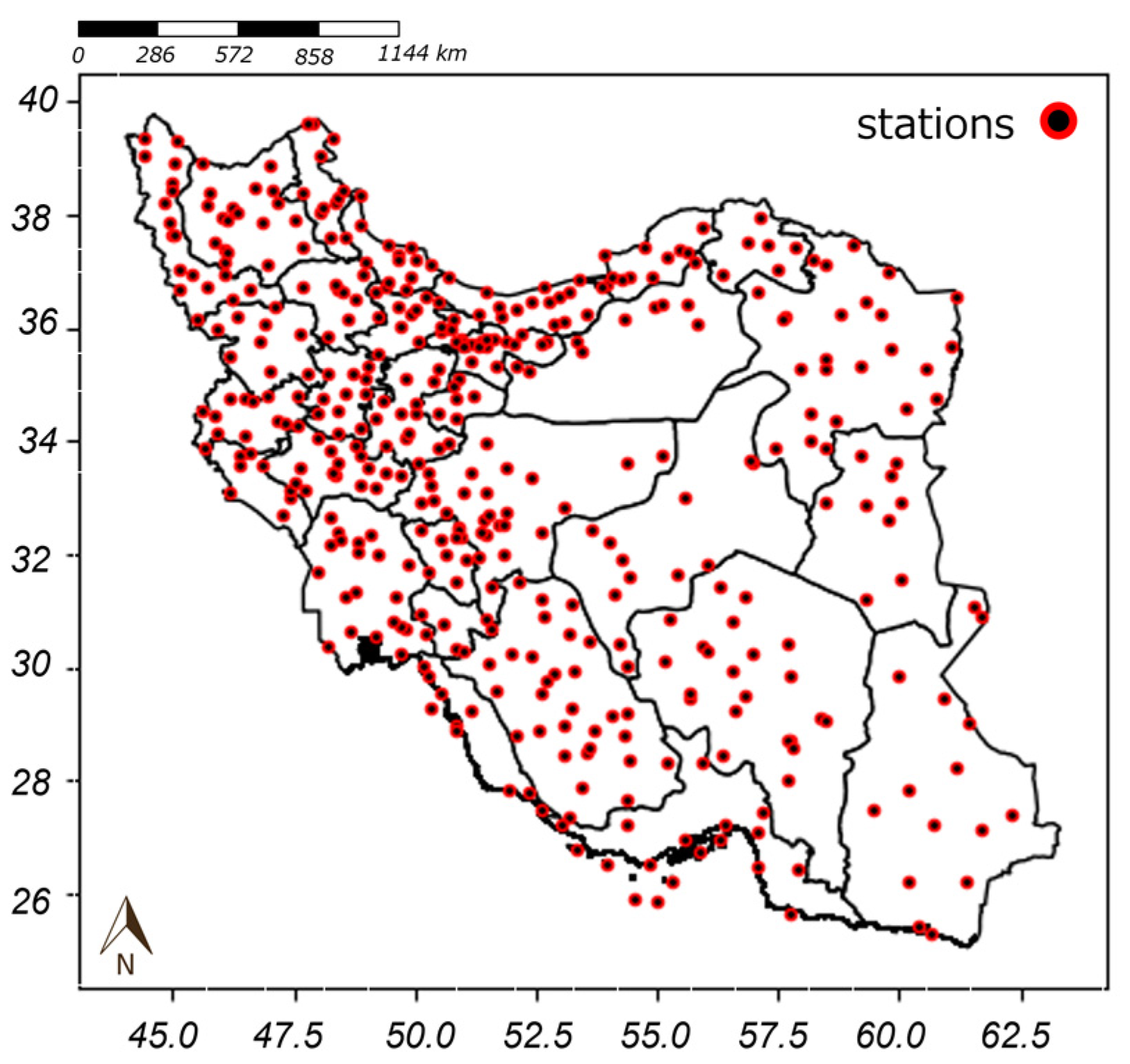
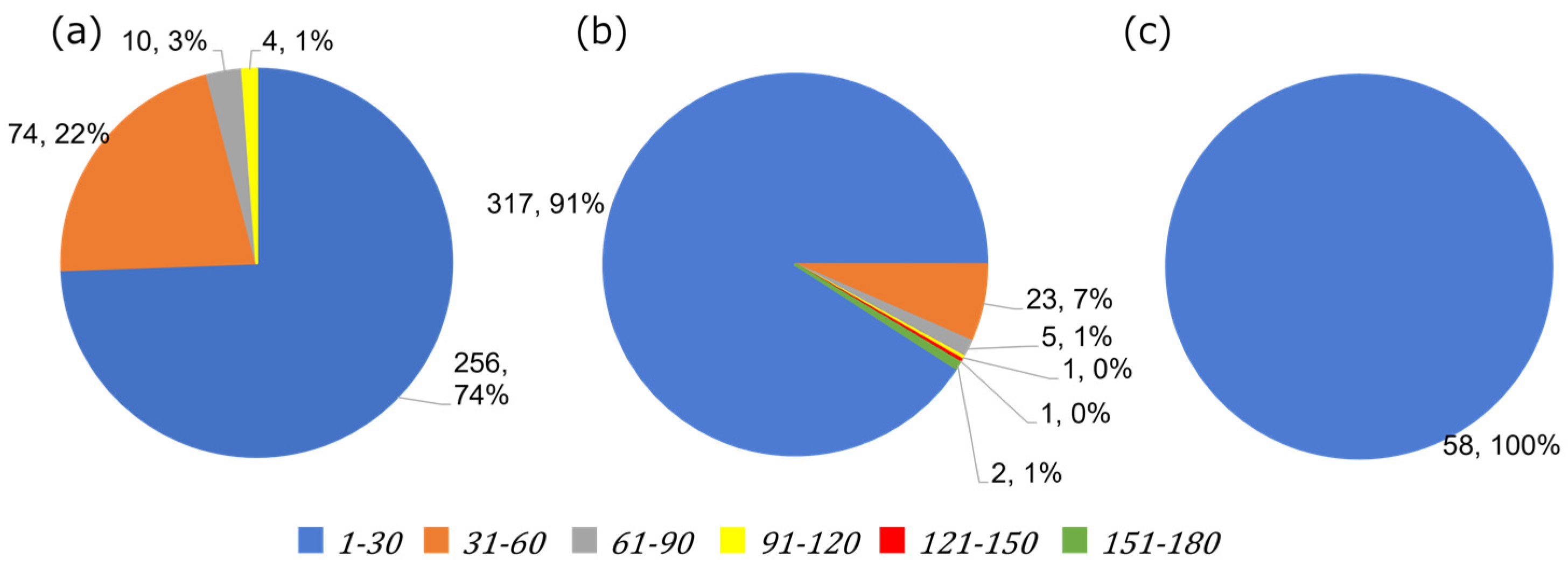
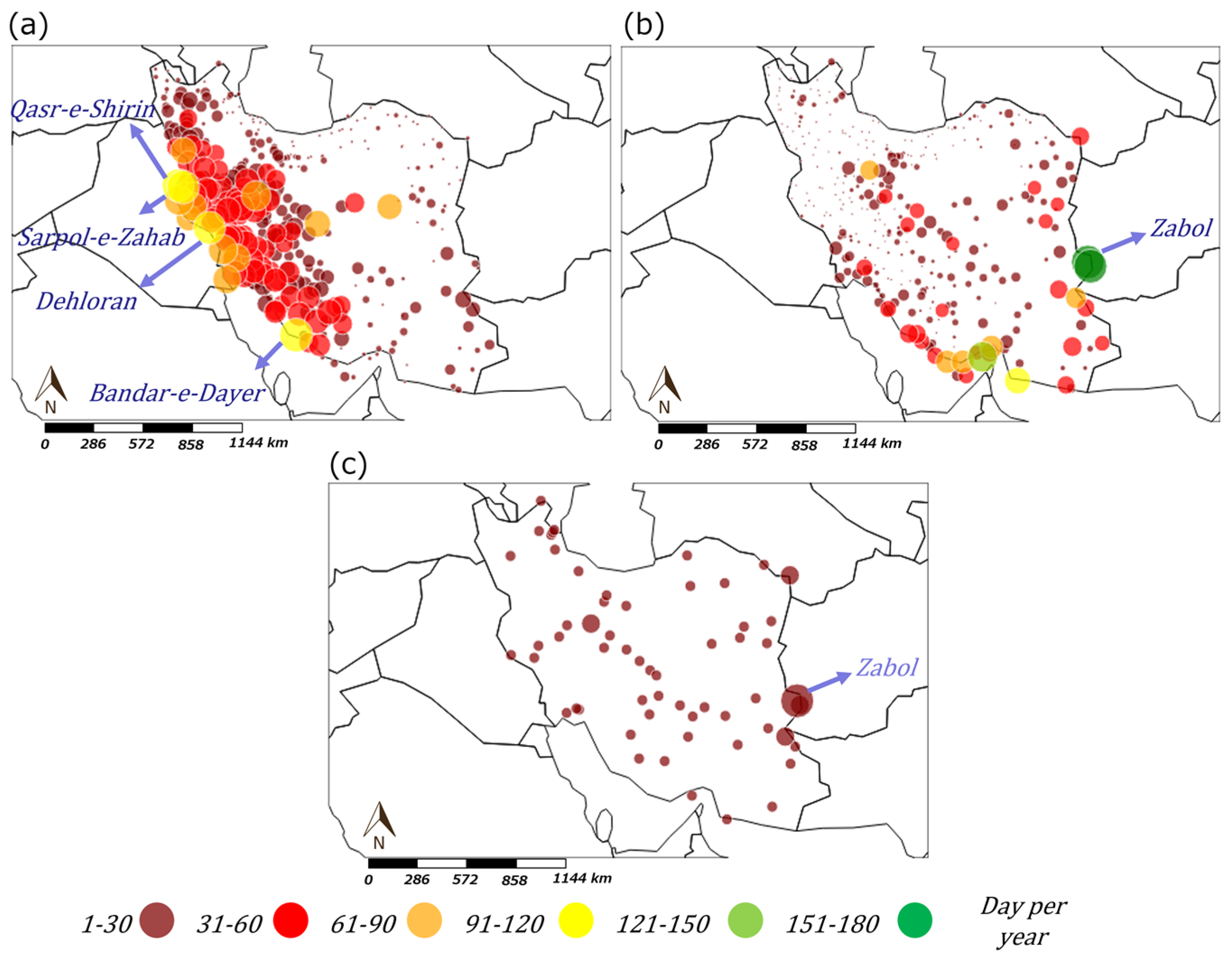
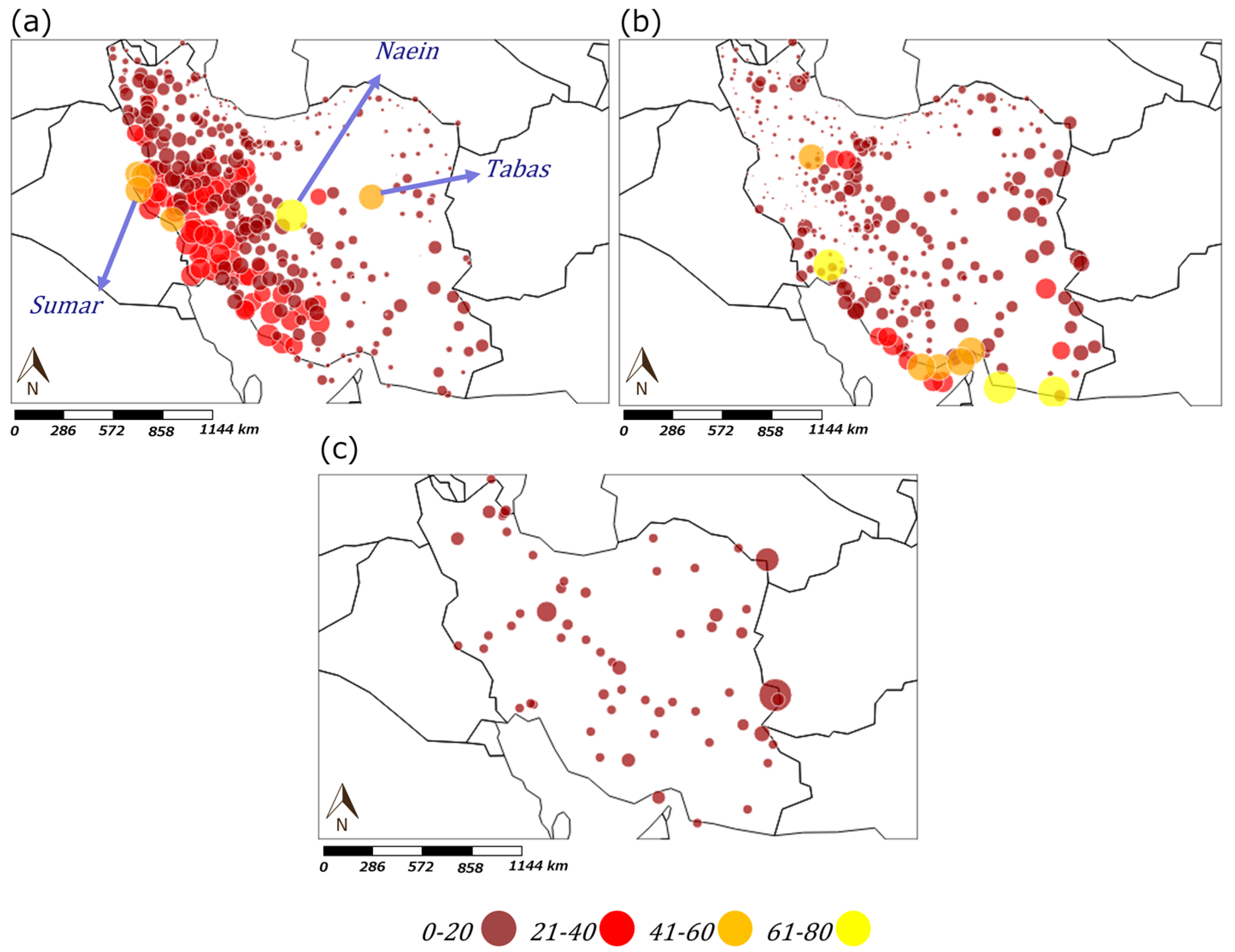
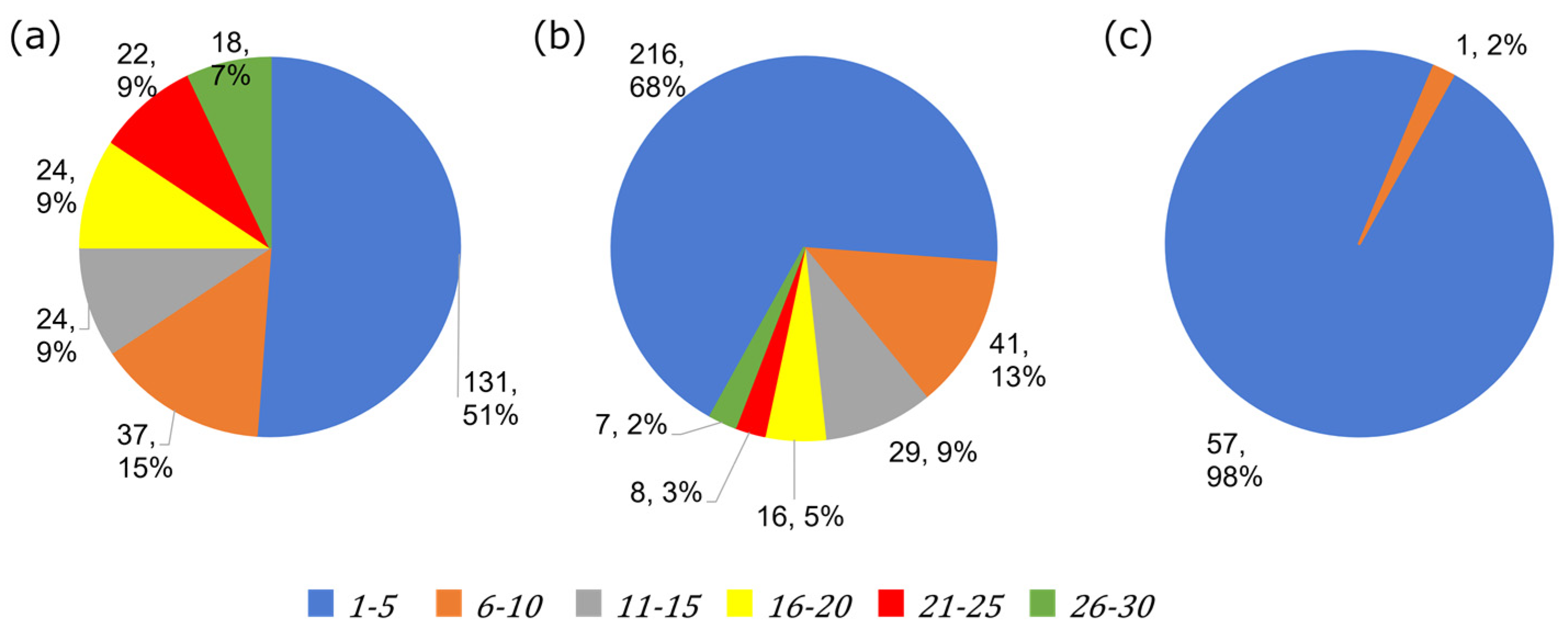
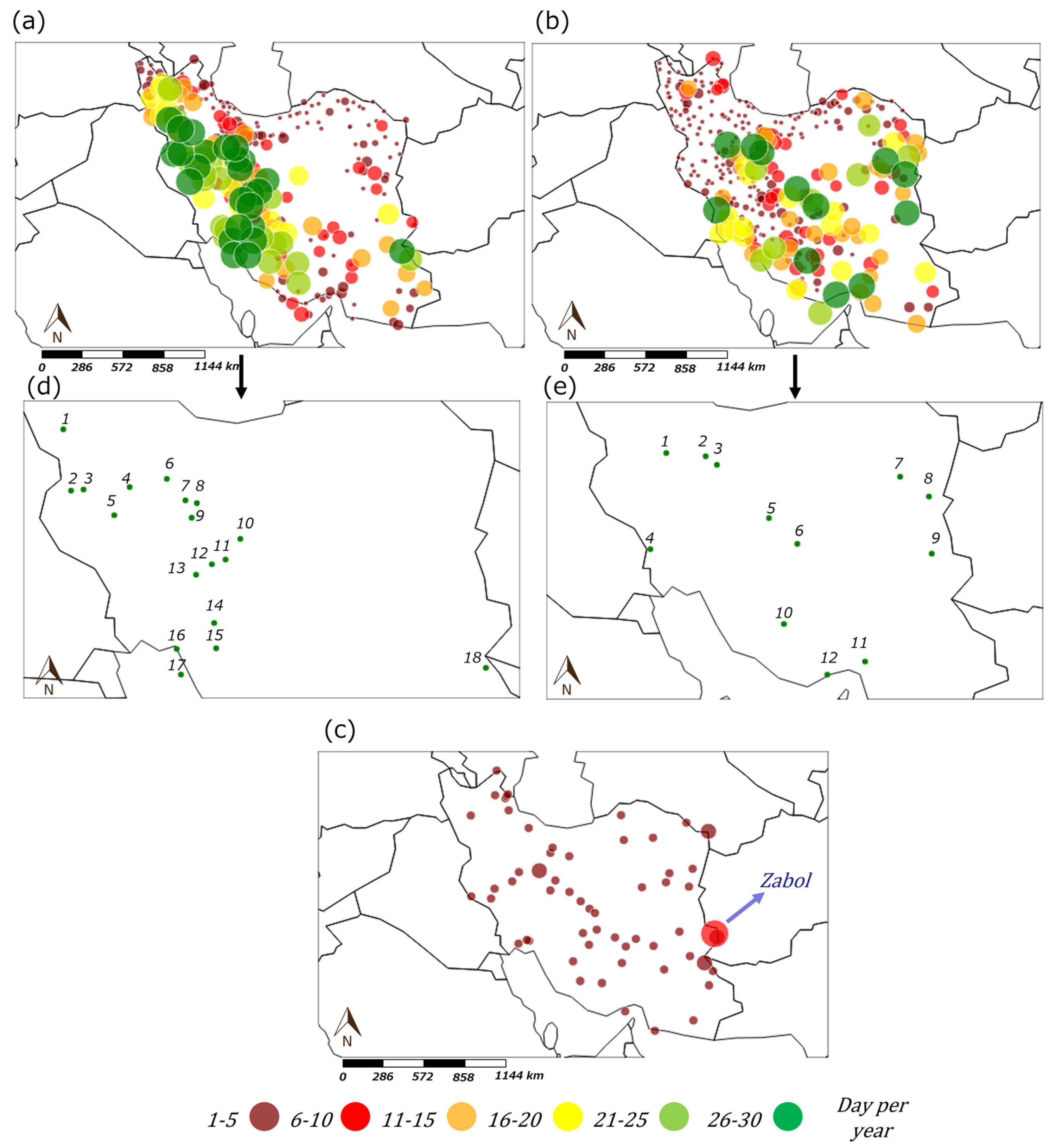
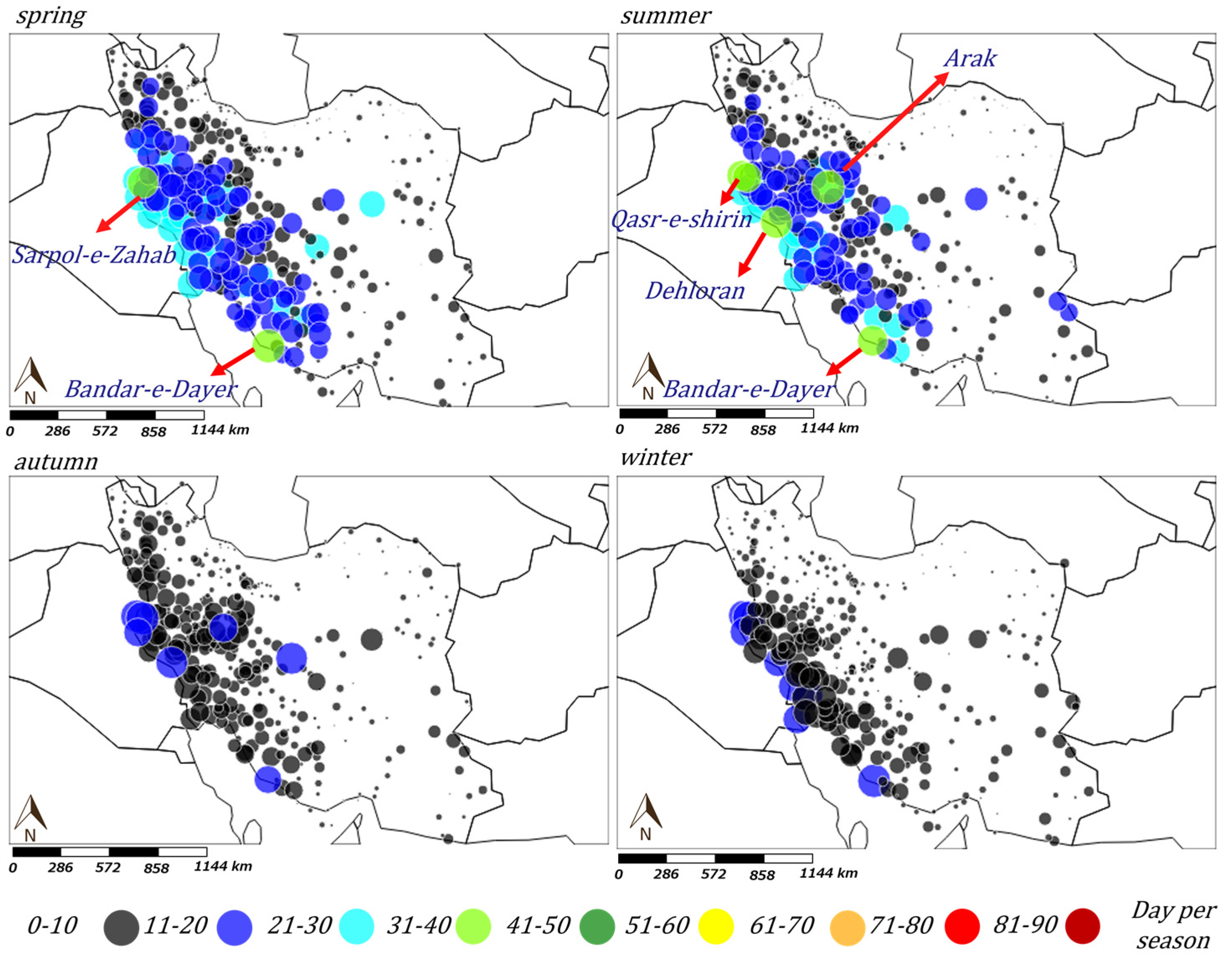
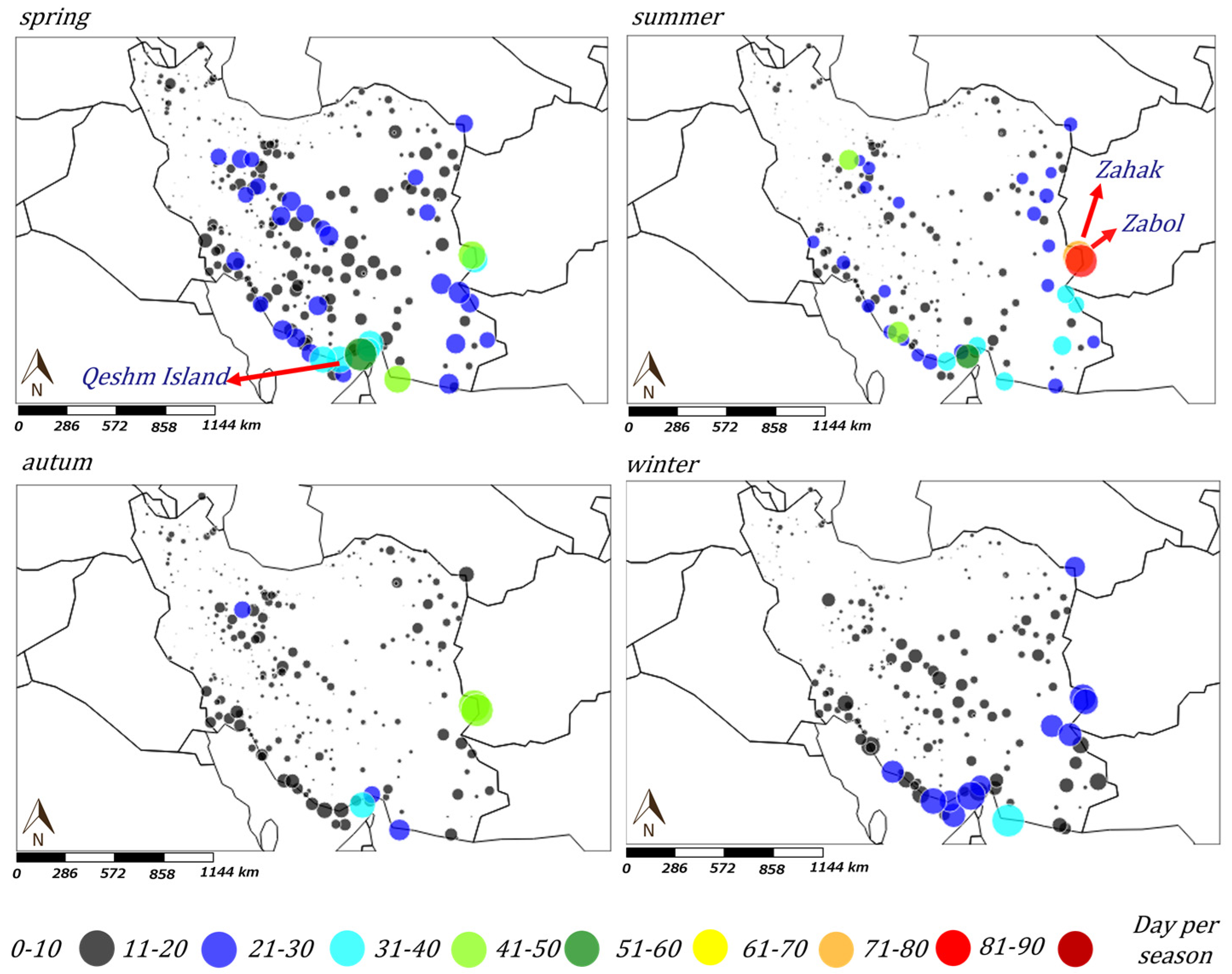
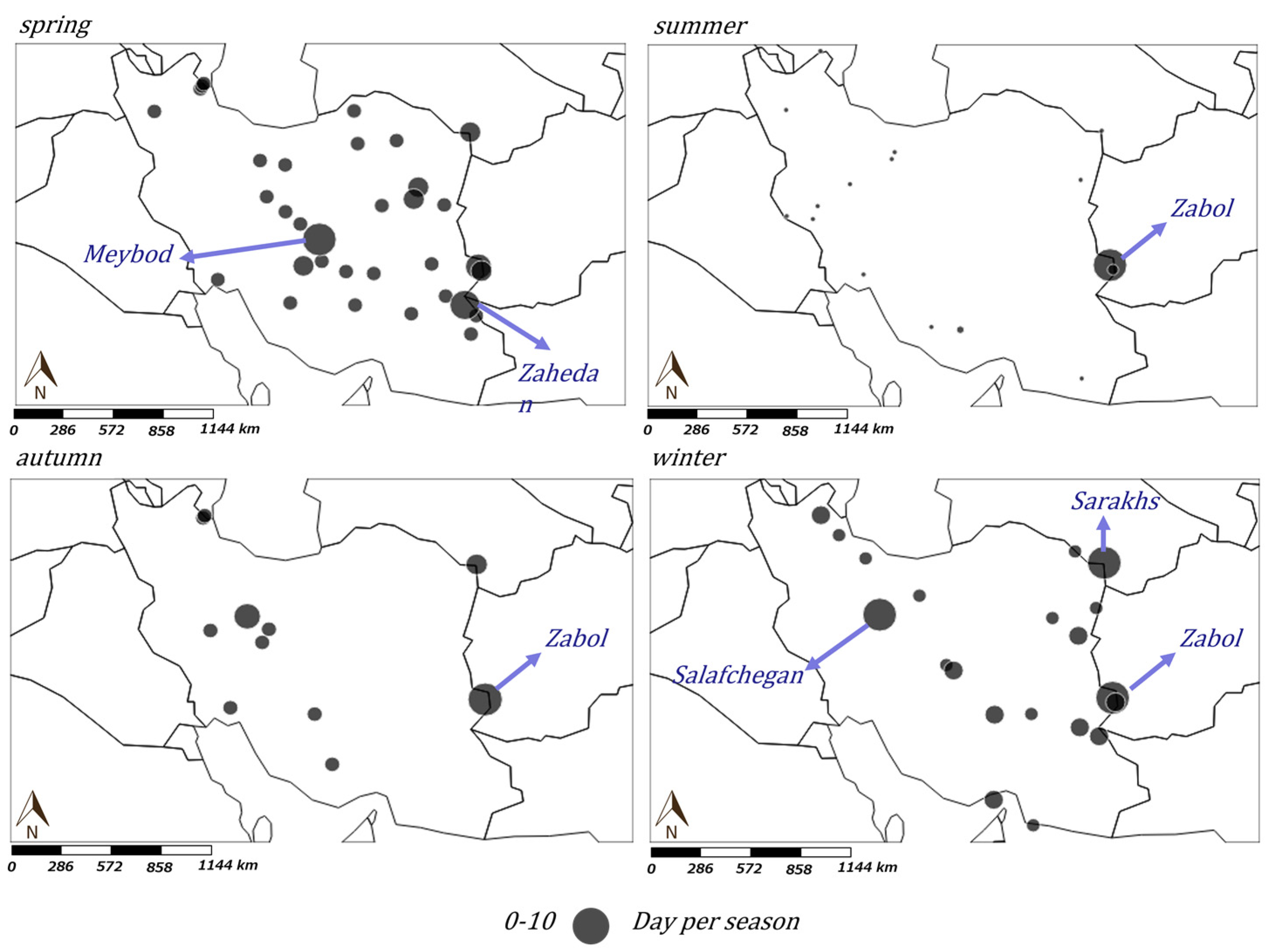
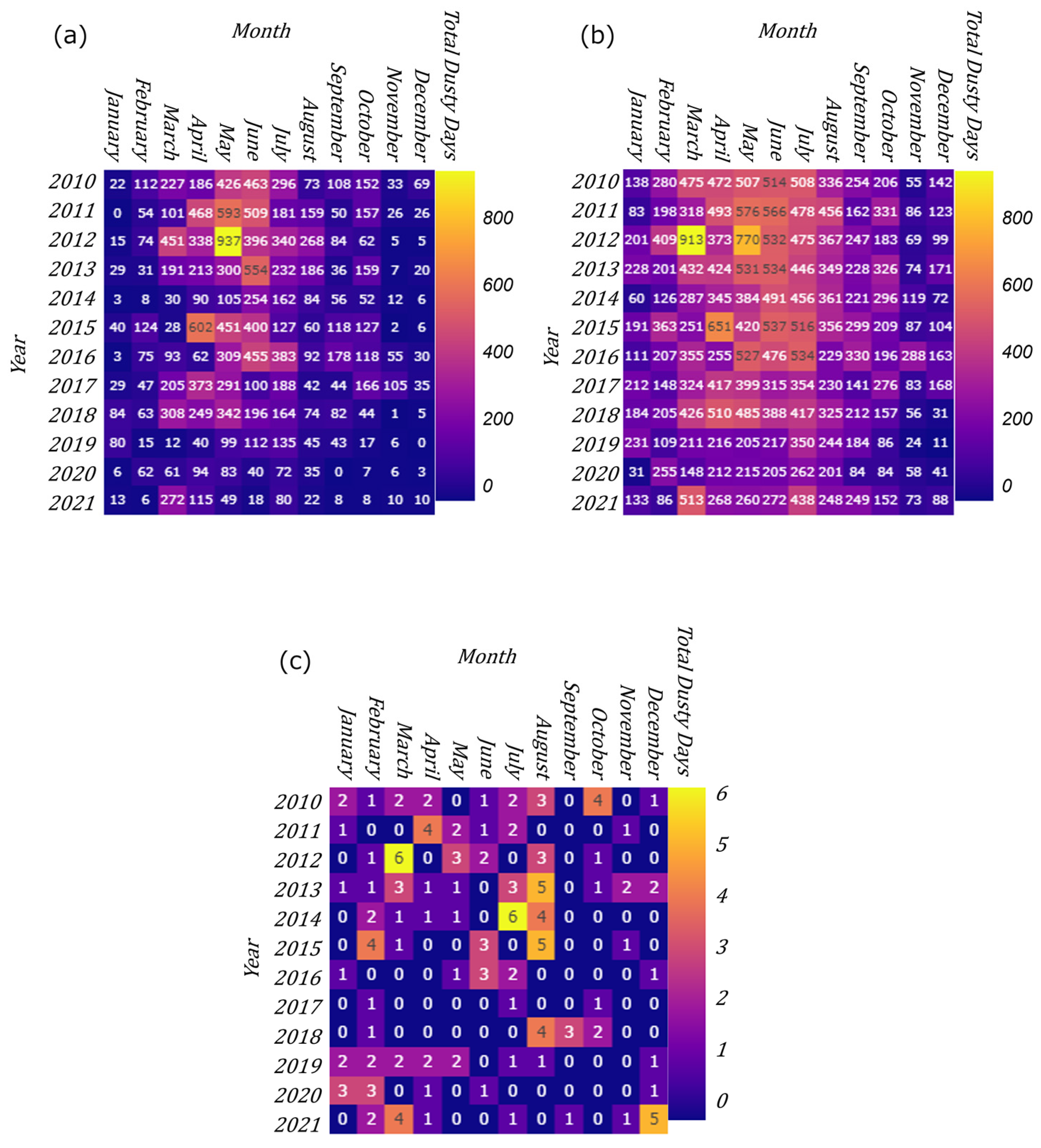

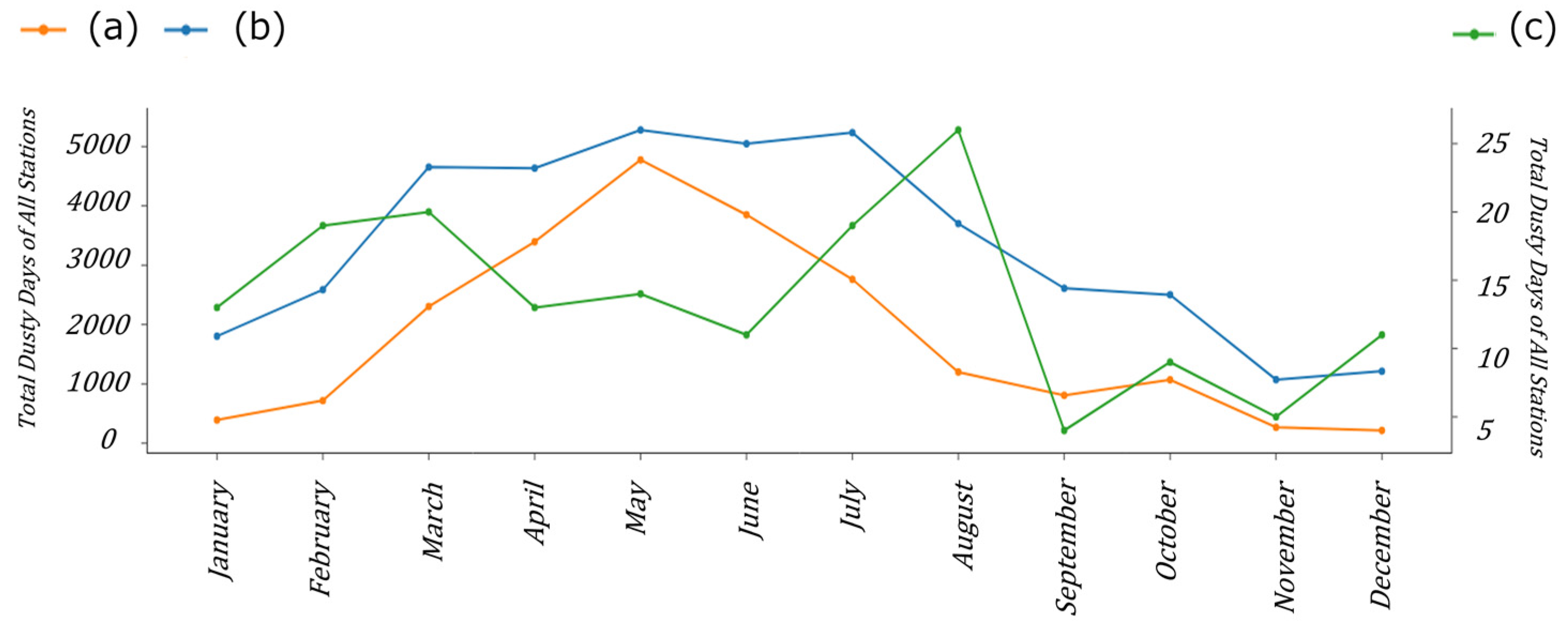
| Class | Suspended Dust | Rising Dust | Dust Storm |
|---|---|---|---|
| Code | 06 | 07 | 33, 34, 35 |
| Description | Dust is suspended in the air but not raised by the wind at or near the station. | Sand and dust are raised by the wind at or near the station. The following VR and WSR are considered. | Severe dusts storms occur with a low VR and strong WSR. |
| Visibility range (VR) | No limit | Between 1 and 10 km | Less than 1 km |
| Wind speed range (WSR) | No limit | Between 7 and 15 m/s | More than 15 m/s |
Disclaimer/Publisher’s Note: The statements, opinions and data contained in all publications are solely those of the individual author(s) and contributor(s) and not of MDPI and/or the editor(s). MDPI and/or the editor(s) disclaim responsibility for any injury to people or property resulting from any ideas, methods, instructions or products referred to in the content. |
© 2023 by the authors. Licensee MDPI, Basel, Switzerland. This article is an open access article distributed under the terms and conditions of the Creative Commons Attribution (CC BY) license (https://creativecommons.org/licenses/by/4.0/).
Share and Cite
Mahmoudi, L.; Ikegaya, N. Identifying the Distribution and Frequency of Dust Storms in Iran Based on Long-Term Observations from over 400 Weather Stations. Sustainability 2023, 15, 12294. https://doi.org/10.3390/su151612294
Mahmoudi L, Ikegaya N. Identifying the Distribution and Frequency of Dust Storms in Iran Based on Long-Term Observations from over 400 Weather Stations. Sustainability. 2023; 15(16):12294. https://doi.org/10.3390/su151612294
Chicago/Turabian StyleMahmoudi, Leila, and Naoki Ikegaya. 2023. "Identifying the Distribution and Frequency of Dust Storms in Iran Based on Long-Term Observations from over 400 Weather Stations" Sustainability 15, no. 16: 12294. https://doi.org/10.3390/su151612294
APA StyleMahmoudi, L., & Ikegaya, N. (2023). Identifying the Distribution and Frequency of Dust Storms in Iran Based on Long-Term Observations from over 400 Weather Stations. Sustainability, 15(16), 12294. https://doi.org/10.3390/su151612294







